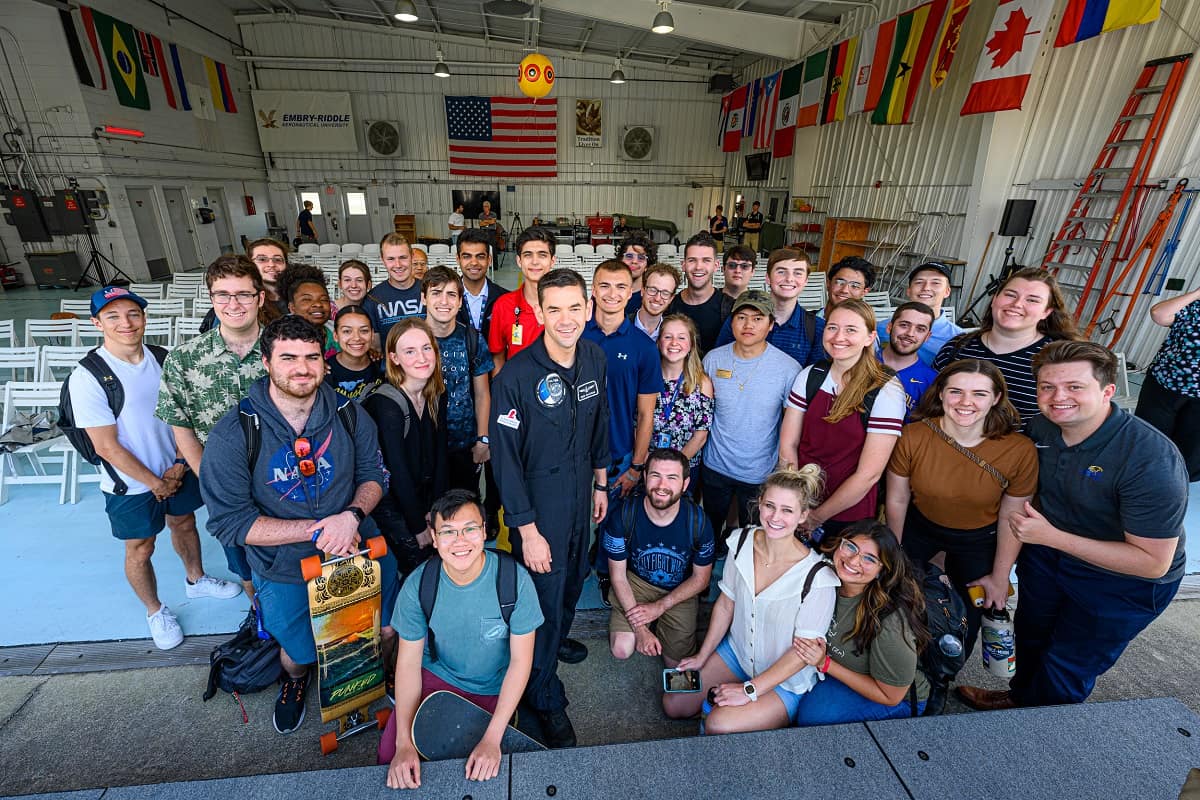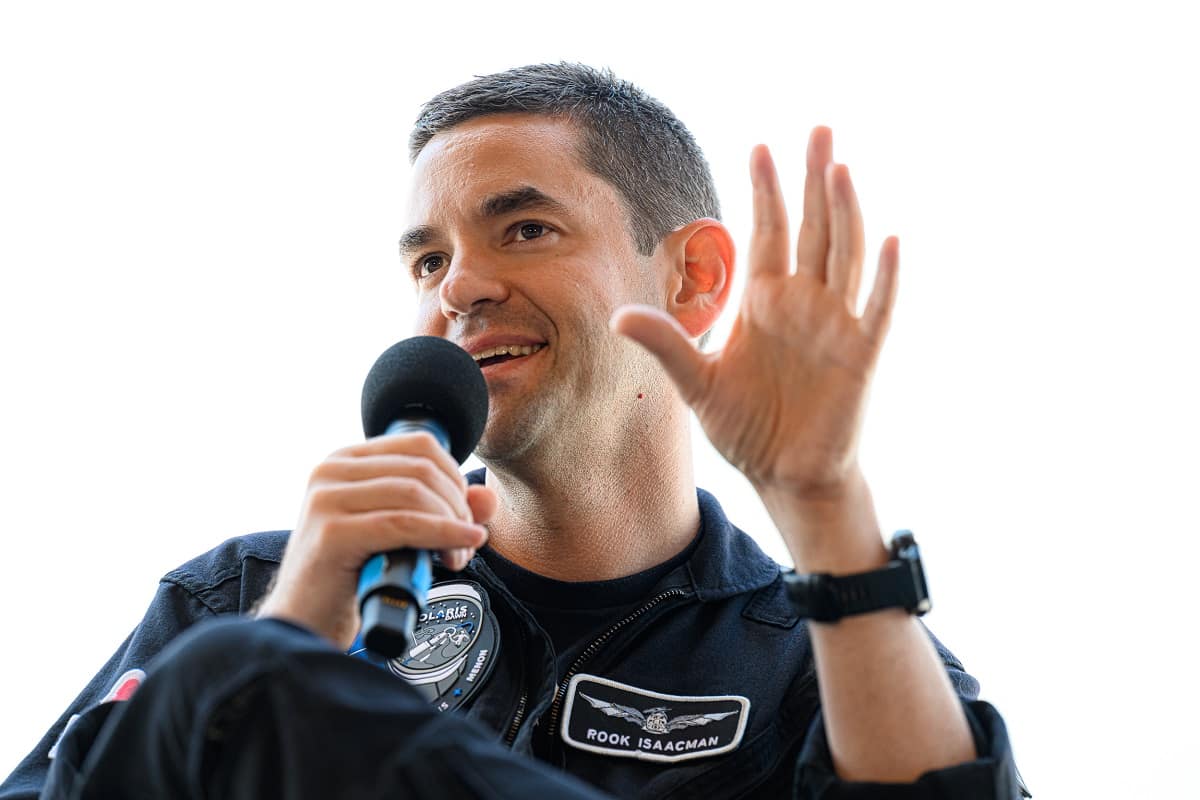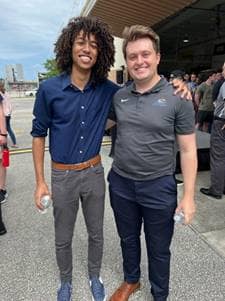Embry-Riddle to Develop Camera System for Upcoming Polaris Dawn Space Mission



Entrepreneur, Polaris Dawn Commander and Embry-Riddle Aeronautical University alumnus Jared Isaacman ('11), who last year led the first-ever all-civilian space mission, visited Embry-Riddle’s Daytona Beach Campus last week to meet the next generation of aviators and speak about how commercial space missions can help create a better world.
During his visit, Isaacman also visited Embry-Riddle’s Space Technologies Laboratory, where a new multi-camera system is being developed that will fly aboard a SpaceX Dragon capsule, launching on a Falcon 9 rocket, with the goal of capturing video of the first-ever commercial spacewalk. Isaacman interacted with students during his time at the lab, offering input on the development of a preliminary 3D-printed camera-system prototype the Eagle team had already developed.
“It was both energizing and inspiring to witness this type of collaboration in action,” said Embry-Riddle President P. Barry Butler, Ph.D., who toured the lab along with Isaacman. “Our students aren’t just reading about spaceflight in books. They’re building hardware with their own hands that will travel into space. They’re an integral part of this mission, interacting directly with its commander who also happens to be a fellow Eagle alumnus. History is happening right here, right now — and our students are right at the center of it.”
Polaris Dawn is the first mission in the Polaris Program, which consists of up to three human spaceflight missions that will demonstrate new technologies, conduct extensive research and ultimately culminate in the first flight of SpaceX’s Starship with humans on board. As for Embry-Riddle’s involvement in the mission, it does not end at the camera’s construction, according to Dr. Troy Henderson, Space Technologies Lab director and associate professor of Aerospace Engineering. In addition, the team will endeavor to use the camera imagery to create virtual reality simulations later. They also plan to test thermal-management material.

Jared Isaacman (center) was greeted to campus by Embry-Riddle President P. Barry Butler (right), College of Aviation Dean Alan Stolzer, Worldwide Campus Chancellor John R. Watret and Worldwide Campus College of Aeronautics Dean Ken Witcher (left). (Photo: Embry-Riddle/Bernard Wilchusky)
“With the successful delivery of EagleCam hardware, the Polaris team approached us about providing a camera payload for the Polaris Dawn mission — and of course the students jumped at the opportunity,” Henderson said. “Working through safety and physical payload requirements in collaboration with Polaris and SpaceX is invaluable for our students, in terms of building both their technical skills and networking abilities. And who wouldn’t want to be part of the first-ever commercial spacewalk?”
In addition to previously leading the Inspiration4 mission, Isaacman is also CEO of Shift4 and founder of Draken International. Similar to Inspiration4, which raised over $240 million for St. Jude Children’s Research Hospital, the Polaris Dawn mission will also work to advance scientific research to improve human health, while continuing to raise funds and awareness for St. Jude.
“In collaboration with the Space Technologies Laboratory, the Polaris Program is endeavoring to film and share the first commercial spacewalk during the Polaris Dawn mission. The resulting footage will provide invaluable data for future spacesuit design and potential future CubeSat deployment mechanisms,” Isaacman said. “Additionally, the footage will bring along the public and help inspire today’s youth to become tomorrow’s engineers, who will continue to make groundbreaking advances in the spaceflight industry with the ultimate goal of opening up access to space for all. Seeing the hard work, passion and ingenuity from the students at Embry-Riddle takes me back to my early days of invigoration with aviation and aerospace, and reminds me of why this work is important.”
Polaris Dawn is currently scheduled for liftoff no earlier than the fourth quarter of 2022. Previously, the Embry-Riddle Space Technology Team developed the EagleCam camera system, which will travel to the moon with the Intuitive Machines Nova-C Lunar Lander, also scheduled for a late-2022 launch.
Commander Isaacman Speaks on Spaceflight, Aerospace Careers
During his first visit to Embry-Riddle’s Daytona Beach Campus last week, Isaacman spoke about his spaceflight and aviation career, as the featured keynote speaker for Aviation Week 2022.
Issacman was interviewed by students Alijah McDonald and Niko Blanks, with Worldwide Campus Dean of the College of Aeronautics Ken Witcher moderating. McDonald is an Aerospace Engineering student and Boeing Scholar, set to intern at The Boeing Company this summer. Blanks, who is a pediatric cancer survivor, is studying Spaceflight Operations and will work for Blue Origin this summer.

Embry-Riddle students Alijah McDonald and Niko Blanks served as interviewers to Jared Isaacman in the Dean’s Hangar Talk, during Aviation Week 2022. (Photo: Embry-Riddle/Ginger Pinholster)
“This is such an exciting time for human spaceflight,” Issacman said, adding that the momentum cannot be taken for granted, however, and that it remains important to reinforce the value of space travel as a means of helping face challenges here on Earth.
As for the experience of spaceflight itself, he cited seeing the moon rise from aboard a spacecraft orbiting Earth as an especially memorable moment which made him realize how much more exploration is needed.
“Seeing the moon was more of an energizing feeling that we can’t let this momentum slow down,” he said. “We’ve just got to keep going.”
Some of Isaacman’s favorite moments in orbit were watching his crew members simply be themselves in microgravity, he said, recalling Chris Sembroski (’07) playing his ukulele and Dr. Sian Proctor doing her artwork. He said another big goal of his mission was to show that everyday people can go to space.
The next step is going to the moon as part of the Polaris Dawn mission, with an eventual goal of putting people on Mars, he said.
“What an amazing time we are living in right now,” he said, noting that using commercial space exploration as a way to give back has always been his primary goal. “That has to be at the forefront of every one of these missions. It’s so important that you’re making as much of an impact here on Earth, as you’re trying to accomplish in space.”
He encouraged students interested in working in the space industry to follow their dreams, adding that there are exciting opportunities throughout this emerging field.
“Just aim high,” Isaacman told students. “This is the time to do it.”
Watch Isaacman’s full presentation online.
*Melanie Azam contributed to this report.
